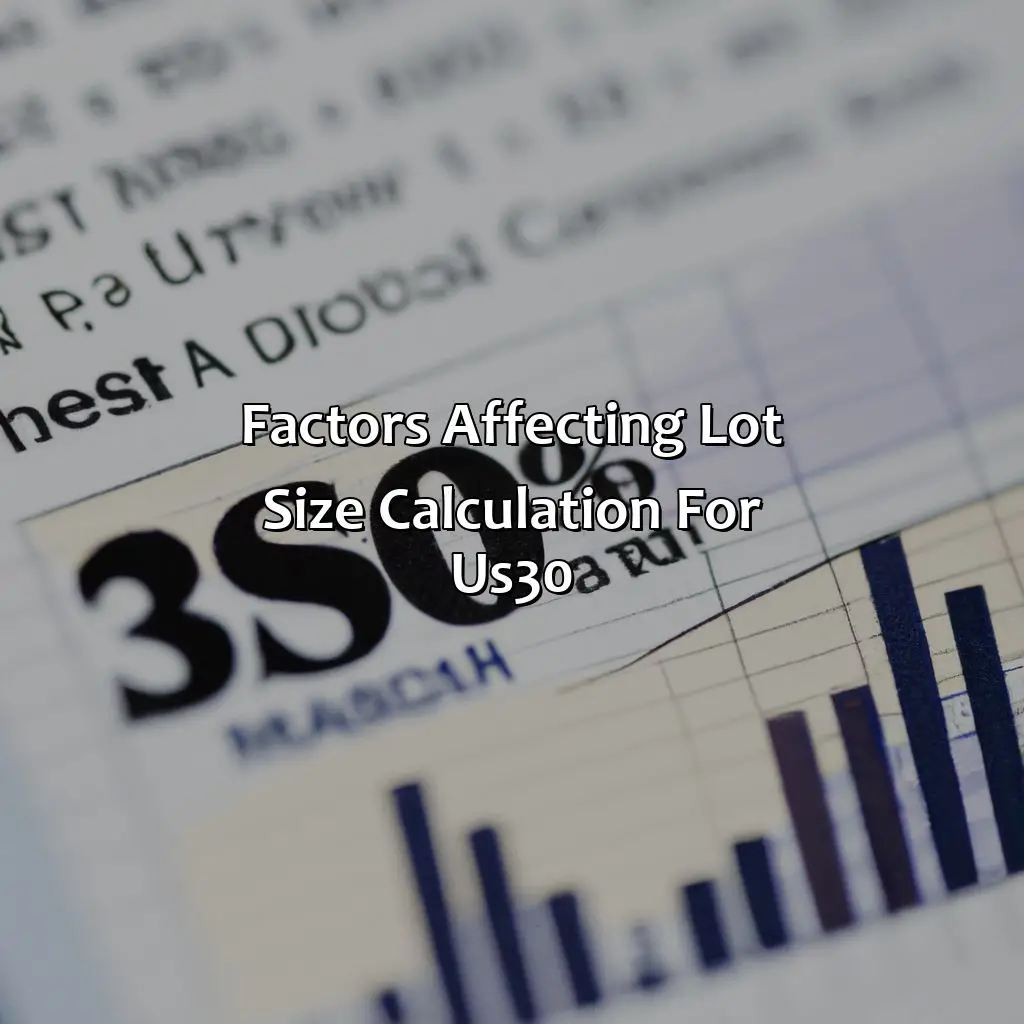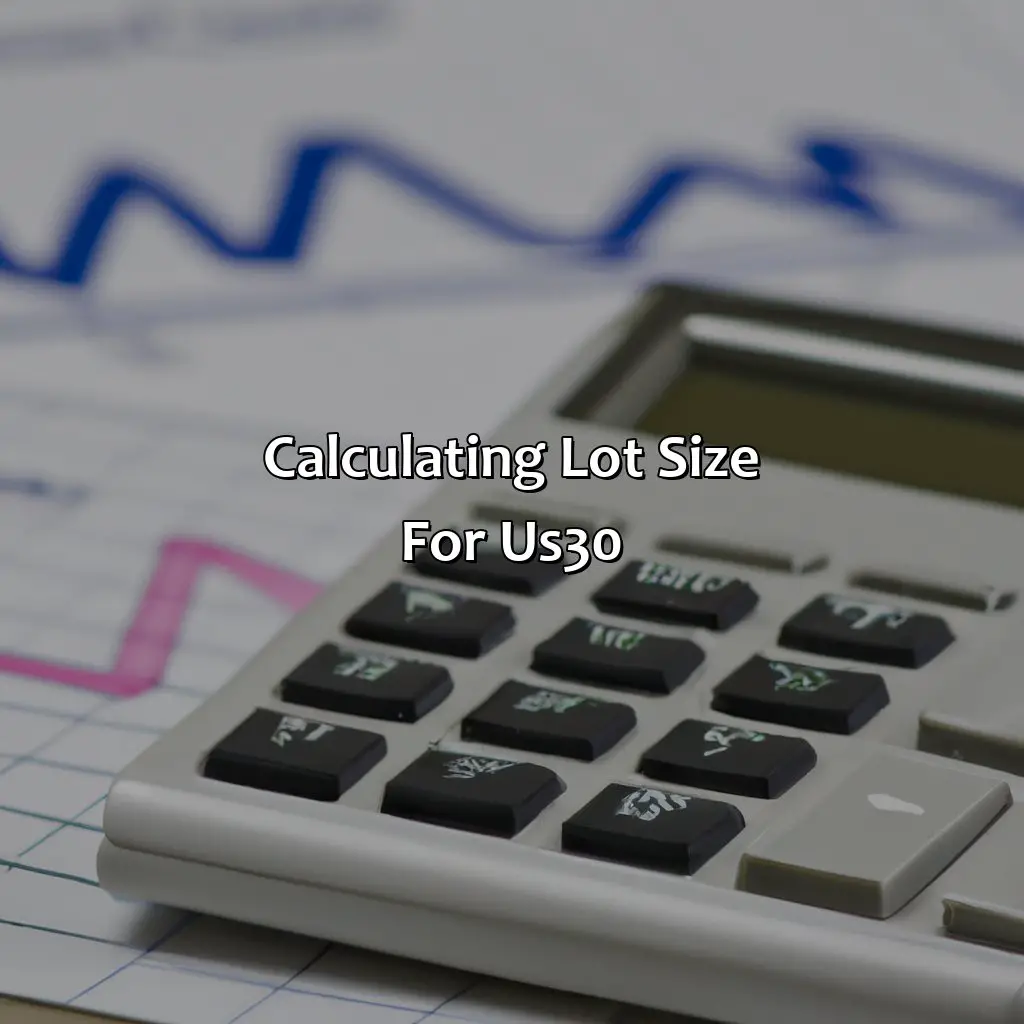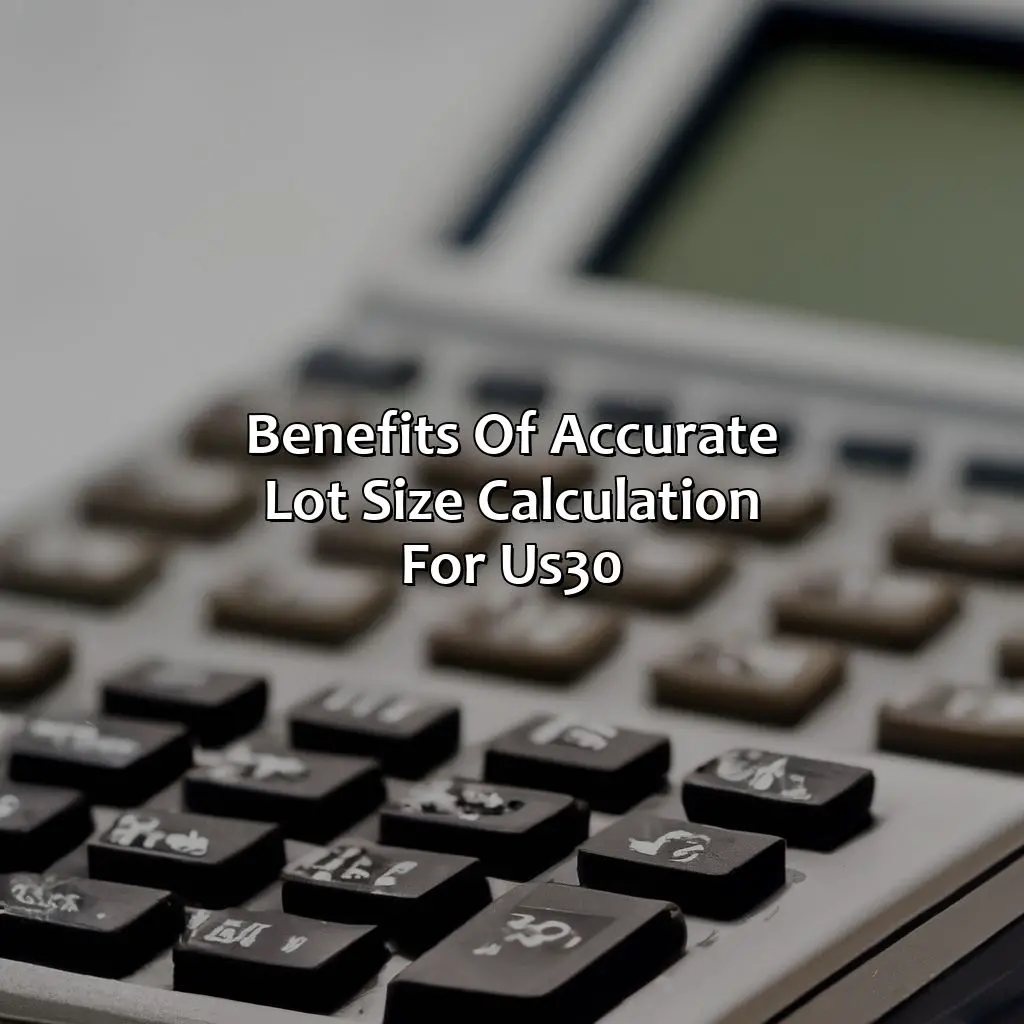
Key Takeaway:
- Lot size for US30 refers to the standardized trading position in the stock market that traders use to manage risk and make profitable trades. Understanding lot size and its calculation is essential for successful trading in forex and the stock market.
- Several factors affect lot size calculation for US30, including account balance, risk tolerance, and leverage. Traders should consider these factors and use appropriate position-sizing strategies, such as the position sizing formula, to manage their trades and avoid losses.
- Calculating lot size for US30 involves four essential steps: determining account currency, deciding on a risk percentage, finding stop loss, and determining lot size itself using position sizing strategies like ATR, standard deviation, Kelly Criterion, or Monte Carlo simulation.
Understanding Lot Size for US30

Photo Credits: forexbrokerreport.com by Matthew Nelson
Calculating Lot Size for US30 in Trading: A Professional Guide
Lot size is a crucial aspect of trading in the forex and stock market. It determines the volume of units that one can take in a trade and also the potential profit or loss. Understanding lot size for US30 is vital for anyone looking to trade in the Dow Jones Industrial Average (DJIA), commonly referred to as US30. Here’s a comprehensive guide on how to calculate lot size for US30.
To start with, below is a table showing different lot sizes for US30 and their corresponding pip values:
| Lot Size | Standard Contract Size | Pip Value |
|---|---|---|
| 1 Lot | 10 | 1 USD |
| 0.1 Lot | 1 | 0.1 USD |
| 0.01 Lot | 0.1 | 0.01 USD |
As seen in the table, a standard contract size for US30 is 10, meaning that one lot is equivalent to trading 10 units of US30. The pip value, which is the price movement of each unit, is 1 USD for one lot. Therefore, for 0.1 lot, the pip value is 0.1 USD, and for 0.01 lot, it is 0.01 USD.
It is important to note that the lot size one can take in a trade depends on their account balance, leverage, and risk tolerance. As such, it is recommended to use a position size calculator to determine a suitable lot size based on these factors.
To enhance profitability and mitigate risks, traders can consider diversifying their portfolio, implementing a stop loss strategy, and monitoring market trends and news.
In summary, understanding lot size for US30 is crucial for profitable trading in the forex and stock market. By using a position size calculator, traders can determine an appropriate lot size based on their account balance, leverage, and risk tolerance. Diversifying one’s portfolio, implementing a stop loss strategy, and staying informed on the market trends and news are also essential in optimizing trading outcomes.
Factors Affecting Lot Size Calculation for US30

Photo Credits: forexbrokerreport.com by Elijah Lopez
To work out the right lot size for US30 trading, you must look at different elements. Balance in your account, risk attitude, and leverage are essential factors for deciding position size and risk management. By assessing your account size, market situation, and trading strategy, you can find the lot size that suits your risk attitude. Plus, you must know the leverage, margin, overnight swap, spread, commission, slippage, execution speed, liquidity, and market depth to calculate the lot size exactly.
Account Balance
Maintaining a favorable account size is crucial in determining your position sizing for US30 trades. Your equity level has a direct impact on the amount you can afford to put at risk while trading and can vary depending on market conditions and your trading strategy. Managing your account balance effectively is key to avoiding over-leveraging and ensuring sustainable trading when calculating lot sizes for US30 trades.
Remember, risk tolerance isn’t just about how much you’re willing to lose, it’s also about how much therapy you can afford.
Risk Tolerance
To effectively manage risk, traders must determine their risk tolerance when calculating lot size. This encompasses the amount of risk an individual can withstand while still staying within position limits and scaling positions accordingly. By understanding one’s own personality traits and investment goals, traders are able to apply proper position sizing formula to optimize returns while minimizing potential losses. Traders often employ various risk management strategies based on their unique preferences in order to minimize market volatility impact on their trades. Position scaling and limiting are just two examples of popular techniques that traders use to reduce downside risk.
Leverage: the financial equivalent of playing with fire, where the smallest mistake can leave you burnt and broke.
Leverage
High Leverage can magnify profits and losses in trading US30. Traders can open larger positions with less margin. However, leverage comes with increased risk of a margin call. It’s important to understand and analyze margin requirements, overnight swap, spread, commission, slippage, execution speed, liquidity and market depth before selecting leverage.
Calculating the appropriate leverage requires considering the account balance, risk tolerance and lot size. High-leveraged trades need extra attention to avoid making major losses. Using proper money management is crucial. Setting stop-loss orders is recommended as it minimizes potential losses.
When the leverage is too high, even a small change in price will trigger a margin call leaving the trader’s position liquidated. Thus, finding a reasonable leverage is essential for success in US30 trading.
In addition to this discussion about leverage, traders must consider other factors like market analysis techniques and potential entry/exit points because successful trading is not about one factor alone; it’s about incorporating multiple factors that affect outcomes.
For example, during volatile news releases such as Federal Reserve meetings or Non-Farm Payroll reports (NFP), using lower leverage is recommended as spreads may widen significantly creating slippage risk.
Calculating lot size for US30: Because you don’t want to be a little fish in a big pond, or a big fish in a little pond.
Calculating Lot Size for US30

Photo Credits: forexbrokerreport.com by Ronald Brown
To work out the lot size for US30 trading, you must follow a few key steps.
- Firstly, take into account the currency of your account and decide on the risk % that suits your initial capital and maximum drawdown.
- Then, establish your stop loss and take profit levels, with the desired risk-reward ratio.
- Lastly, use various position sizing formulas such as ATR, standard deviation, Kelly Criterion, or Monte Carlo simulations to calculate the lot size.
Step 1: Determine Account Currency
To calculate the lot size for US30, the first step is to determine the account currency. This is important because it impacts how much value each pip movement in the US30 will have on the account balance.
Here’s a 3-step guide to help with this process:
- Identify the account type: Before choosing an account currency, determine if the account is denominated in USD or another currency.
- Match currency pairs: Select a currency that matches one of the base currencies in a currency pair – EUR/USD, GBP/USD, or USD/JPY are all acceptable options.
- Calculate margin: To avoid any surprise costs down the road, create an accurate calculation of the margin required for opening a position with this chosen account currency.
It’s important to note that selecting an appropriate account currency based on your trading strategy can be pivotal in determining potential profits and losses.
The lot size calculation process for US30 can be complex but accurate calculations can provide great benefits. For instance, it helps traders minimize risk by defining their exposure levels and ensuring they don’t lose more money than they are comfortable with.
A true fact about this topic is that many online brokers offer calculators or other tools that can take some of these calculations out of trader’s hands and simplify things further.
Risk management is the financial equivalent of wearing a helmet while skateboarding – it may not look cool, but it’s a smart move to protect your initial capital from maximum drawdown.
Step 2: Decide on Risk Percentage
To ensure effective risk management, Step 2 requires deciding on the percentage of your initial capital to risk. This determines the lot size in relation to your stop loss and potential loss. Being aware of maximum drawdown can also influence this decision.
The following are the steps to follow:
- Determine initial capital
- Decide on risk percentage based on personal risk tolerance
- Consider maximum drawdown when determining risk percentage
- Use a position size calculator to find corresponding lot size
- Re-evaluate and adjust risk percentage as necessary
Proper execution of Step 2 ensures efficient allocation of funds while minimizing exposure to unnecessary risk, ultimately resulting in maximization of profit potential.
Find your stop loss and take profit before entering the US30 market, or risk getting lost in profit targets and risk-reward ratios.
Step 3: Find Stop Loss
To ensure a successful trade, it is crucial to determine the stop loss before executing it in the market. It helps traders manage their losses and maximize profits.
- Step 1: Analyze market conditions and technical indicators to identify possible support and resistance levels.
- Step 2: Determine the risk percentage for this trade based on account balance and risk tolerance.
- Step 3: Use the identified support and resistance levels along with the determined risk percentage to set an appropriate stop loss level.
- Step 4: Additionally, set a take profit or profit target level based on desired risk reward ratio.
Setting an appropriate stop loss ensures that traders limit their losses in case of adverse price movements, reducing their overall exposure to risks while trading US30. Traders should avoid setting overly tight stop losses as it may lead to premature closure of trades and missed opportunities.
For instance, experienced traders use trailing stop-loss orders that move up or down automatically as per market movement to lock profits at predetermined intervals.
It is essential for all traders, whether beginners or experts, to understand the significance of finding an appropriate stop-loss level when calculating lot size for US30 trades.
Gambling with lot sizes is like playing Russian roulette with your trading account, use a position sizing formula instead.
Step 4: Determine Lot Size
Determining the appropriate lot size for US30 is a critical step towards achieving trading success. This involves calculating the position sizing formula to determine the lot size that is appropriate for each trade based on individual factors that affect risk and reward.
To determine the lot size, follow these 4 steps using ATR, standard deviation, Kelly criterion or Monte Carlo simulation:
- Calculate the Risk Percentage: Determine how much of your account you are willing to risk per trade. Typically, most traders risk 2% or less per trade.
- Find Stop Loss: Identify where you would place your stop loss based on your strategy or technical analysis.
- Position Size Calculation: Use one of the above formulas to calculate the optimal position size based on your account currency balance, risk percentage and stop loss level.
- Determine Lot Size: The final step is to decide how many lots to trade based on the calculated position size.
It is important to note that some brokers offer fractional lot sizes which allow traders greater flexibility in positioning their trades.
In addition to these steps, it’s essential you understand unique details specific to US30 market volatility trends and investor sentiment when determining position sizes.
To improve accuracy in determining lot sizes, consider experimenting with different formulas such as incorporating ATR or utilizing Monte Carlo simulations when calculating position sizes.
By accurately estimating lot sizes through effective decision-making processes and choosing an optimal range of investment sizing models as discussed above can enhance trading opportunities for traders while creating favorable outcomes over time.
Accurate lot size calculation can be the key to smart money management, leading to successful trading in the fast-paced world of US30.
Benefits of Accurate Lot Size Calculation for US30

Photo Credits: forexbrokerreport.com by Sean Garcia
When it comes to trading in the stock market, accurate lot size calculation is essential for effective money and risk management. Understanding the benefits of accurate lot size calculation for US30 can significantly help traders achieve their financial goals.
- Accurate lot size calculation can minimize the risk of large financial losses in forex trading.
- It helps traders to properly manage their funds and minimize trading errors.
- Effective lot size calculation ensures precise entry and exit points, thereby increasing profit potential.
- Proper lot size calculation helps traders effectively use leverage, reducing the risk of margin calls.
- Accurate lot size calculation helps in maintaining discipline while trading in the stock market, thereby improving overall performance.
By having an in-depth understanding of the benefits of accurate lot size calculation for US30, traders can make informed decisions and optimize their strategies for maximum profitability. It is crucial to use proper lot size calculation methods to minimize risk and achieve desired financial outcomes.
It is imperative to remember that effective money management and risk management are the keys to success when it comes to trading. By utilizing accurate lot size calculation methods, traders can have a better understanding of their financial situation and make informed trading decisions.
A successful trader once shared his experience of how proper lot size calculation helped him prevent significant financial losses. By effectively managing his funds and using proper lot size calculation methods, he was able to minimize the risk of losing large sums of money while trading in US30.
Five Facts About How to Calculate Lot Size for US30:
- ✅ The US30 lot size is based on the contract specifications of the broker you are using. (Source: Admiral Markets)
- ✅ The US30 is also known as the Dow Jones Industrial Average or DJIA. (Source: Investopedia)
- ✅ To calculate the lot size for US30, you need to know the pip value, leverage, and margin requirements. (Source: My Trading Skills)
- ✅ The minimum lot size for US30 is usually 0.1 lots, but it can vary depending on the broker. (Source: Forex.com)
- ✅ A higher lot size can lead to greater potential profits or losses, so it’s important to calculate properly and manage risk. (Source: FXCM)
FAQs about How To Calculate Lot Size For Us30
How to calculate lot size for US30?
Calculating lot size for US30 requires understanding of certain variables including leverage, risk, and account balance. One of the common ways of calculating lot size is by determining your risk tolerance level and setting a stop-loss order. The stop-loss level can be used to calculate the lot size based on the percentage of risk you are willing to take.
What is the significance of lot size in US30 trading?
Lot size is significant in US30 trading because it determines the position size and the potential profits or losses in a trade. It also affects margin requirements and the amount of capital required to enter into a trade. Understanding lot size helps traders to manage risks effectively and make informed trading decisions.
What is the standard lot size for US30 trading?
The standard lot size for US30 trading is 1 lot which represents 100 units of the underlying asset (US30). A trader can increase or decrease the lot size based on account balance and risk tolerance level. Different brokers have different lot size options, so it’s important to check with your broker’s trading conditions.
How can I calculate the value of a pip for US30?
The value of a pip for US30 is determined by multiplying the pip value by the lot size and the exchange rate. For instance, if 1 pip value for US30 is $0.10, and you trade 1 standard lot (100 contracts) at an exchange rate of 1.1800, the pip value will be $10 (0.10*100*1.1800).
What is the maximum lot size for US30 trading?
The maximum lot size for US30 trading depends on the broker’s margin requirements and the trader’s account balance. Most brokers have a maximum lot size of 50 lots, but some may have higher or lower limits. It’s important to check with your broker’s trading conditions to know the maximum lot size that you can trade.
How can I reduce risk when trading with a large lot size?
One way to reduce risk when trading with a large lot size is by using stop-loss orders to limit potential losses. It’s also crucial to have a clear risk management strategy that involves diversifying your portfolio and keeping a reasonable account balance. You can also monitor market news and trends to make informed trading decisions.


